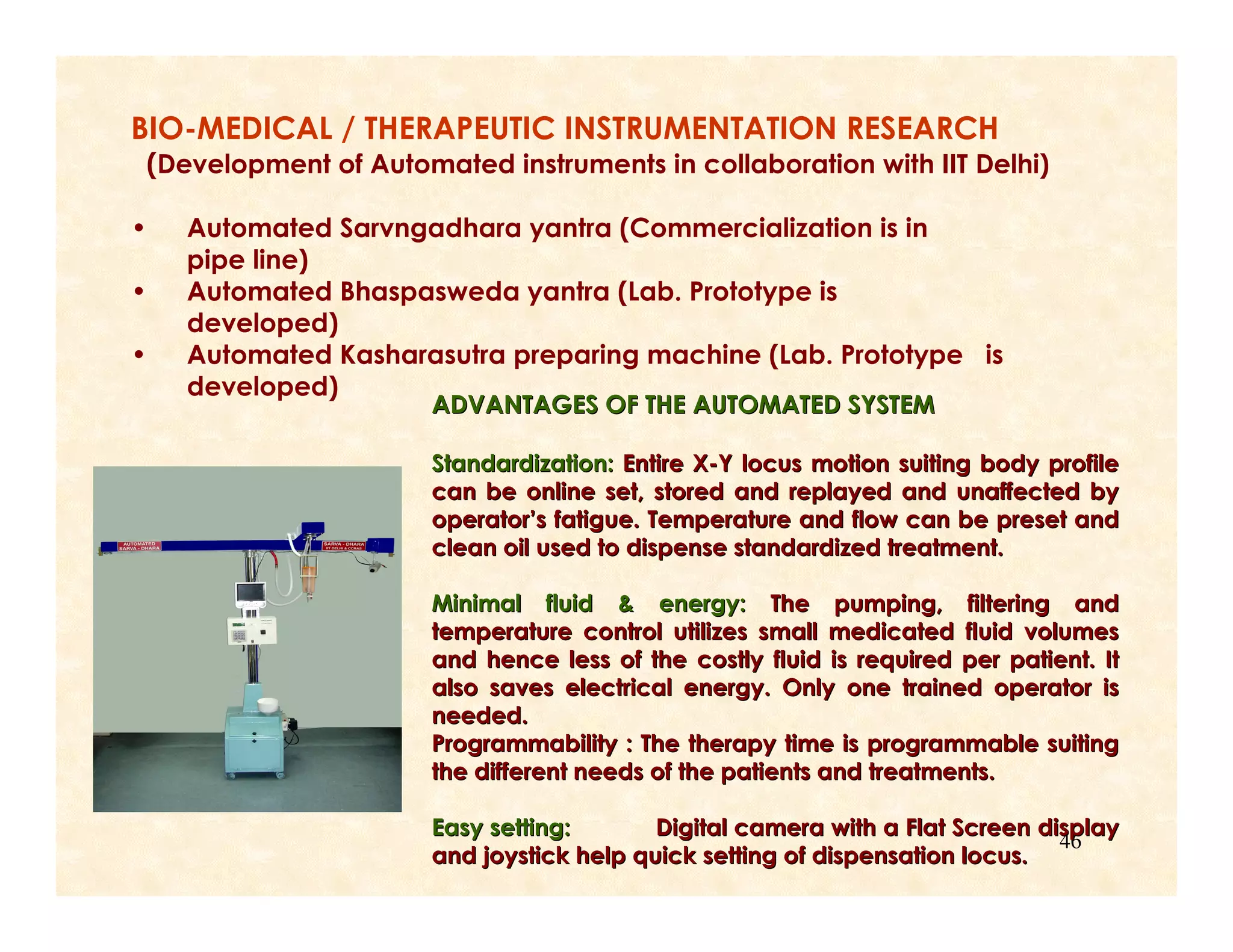The document outlines the principles and practices of Ayurveda, emphasizing its ancient origins in Vedic texts and the importance of a holistic approach to health, prevention, and individualized treatment. It details the evolution of Ayurvedic practices, including pharmacopoeia and therapeutic methodologies, while highlighting the growing global popularity of Ayurveda as a complementary approach to manage chronic conditions. Additionally, the document discusses the safety, efficacy, and regulatory framework for Ayurvedic practices in India, supported by a structured research framework aimed at promoting evidence-based approaches in Ayurveda.





















![AYUSH 64– AN AYURVEDIC
ANTI-MALARIAL DRUG
Drug : Ayush-64 Vs Chloroquine
[Picrorhiza kurroa, Alstonia scholaris,
Swertia chirata&Caesalpinia bonducella]
Findings : * Temperature tends to normalcy.
* Maintenance of Thymol turbidity[P<0.05]
* Significant decrease in lymphocytes, total
disappearance of parasite & clinical improvement
were seen in 72.4 -95.4 % in comparison with
100 % in control group in various level of studies .
SIDE EFFECTS: No side/toxic effects in prescribed doses
(Double blind)
IPR Status -Patent No. 152863 dated 28.7.198
Ref ;M.V.Chary et al., Double-blind Clinical Trail with Ayush-64 an Ayurvedic drug
in P.Vivax Malaria, Journal of Rersearch in Ayurveda and Siddha Vol.VI No.1, 3&4:105-
22
116,1985.](https://image.slidesharecdn.com/evidencebasedayurveda-120319082009-phpapp01/75/Evidence-based-ayurveda-22-2048.jpg)
![777 OIL FOR PSORIASIS
DRUG : 777 OIL
[Wrightia tinctoria]
FINDINGS : Significant response was observed in 80% patients .
The recurrence is postponed and the Intensity of the
lesions is very much minimized .The efficacy of the drug
is also supported by histopathological studies.
(open study)
Before treatment After treatment
23
IPR Status - Patent No. 166740 dated 11.9.1987](https://image.slidesharecdn.com/evidencebasedayurveda-120319082009-phpapp01/75/Evidence-based-ayurveda-23-2048.jpg)



![SHUNTHI GUGGULU FOR RHEUMATOID ARTHRITIS
DRUG : SHUNTHI GUGGULU
[Zingiber officinale &
Commiphora mukul]
FINDINGS : Significant response was observed
in 72% cases. There was marked
improvement of signs and symptoms
besides significant changes in lab.
parameters like,ESR etc.
(open study )
Ref;CCRAS Research An Over View, Central Council for Research in Ayurveda and Siddha.
Janakpuri, New Delhi-2002 27](https://image.slidesharecdn.com/evidencebasedayurveda-120319082009-phpapp01/75/Evidence-based-ayurveda-27-2048.jpg)
![AYUSH-82 FOR DIABETES MELLITUS
DRUG : AYUSH-82 [Mangifera indica,
Syzygium cumini, Gymnema
sylvestris, Momordia charantia]
FINDINGS : Fall in FBS, PPBS after treatment
was significant (0.001) besides 75%
good response on subjective
assessment.
(open study )
Ref;CCRAS Research An Over View, Central Council for Research in Ayurveda and
Siddha. Janakpuri, New Delhi-2002
28](https://image.slidesharecdn.com/evidencebasedayurveda-120319082009-phpapp01/75/Evidence-based-ayurveda-28-2048.jpg)
![A CONTROLLED CLINICAL TRIAL OF GUGGULU AND P.E.
EXT. OF GUGGULU IN OBESITY AND LIPID DISORDERS
Drugs : Guggulu , P.E. Ext. of Guggulu Vs Placebo
Findings: - Reduction in serum cholesterol was observed in
all cases.
- Significant weight reduction was found in P.E. extract
treated group [2 kg/month] when compared with
Guggulu group [1 kg/month].
(Double blind)
Ref;Clinical and Experimental Trial of Guggulu (Medo-Roga). 1989Central Council
29
for Research in Ayurveda and Siddha. Janakpuri, New Delhi.](https://image.slidesharecdn.com/evidencebasedayurveda-120319082009-phpapp01/75/Evidence-based-ayurveda-29-2048.jpg)
![AYUSHMAN-8 IN MENTAL RETARDATION
DRUGS : AYUSHMAN-8 VS PLACEBO[STARCH]
[Centella asiatica & Bacopa monierri]
Age Group : 5-16 years
Findings : * Binet-Kamat Test-Numerical increase in mental age
was greater in drugs group [p=0.05<P<0.1].
* SEGUIN- Form board Test: Increase in mental age
shown was significant when compared to Placebo
group [P>0.01]
* Clinical improvement.
Ref V. Rajagopalan et al Effect of Ayushman-8 in Mental retardation, Journal of
Research in Ayurveda and Siddha, Vol.XIX-No.3-4 (1998), p. 89-97.
30
(Double blind)](https://image.slidesharecdn.com/evidencebasedayurveda-120319082009-phpapp01/75/Evidence-based-ayurveda-30-2048.jpg)
![ADOUBLE BLIND CONTROLLED STUDY ON THE
ROLE OF BRAHMYADIYOGA AND TAGARA IN
ACUTE SCHIZOPHRENIA
Drugs : 1. Brahmyadi Yoga
1NGREDIENTS
i. Manduk parni (Centella asiatica)
ii. Jatamansi Root ( Nardostachys jatamansi)
iii. Kustha (Sausurea lappa)
iv. Sarpagandha ( Rauwolfia serpentina)
v. Vacha (Acorus calamus))
2.Tagara.
3.Standard control : Chlorpromazine Vs Placebo[Starch]
Findings :
1. The mean difference effectiveness of Brahmyadi Yoga is
better than that of Tagara[P<0.005] and Placebo[P<0.001]
besides clinical improvement.
2. The mean effectiveness of Brahmyadi Yoga and
chlorpromazine is not significant [P>0.05].
3. The Anti-psychotic effect of Brahmayadi Yoga is better than
Tagara and Placebo and comparable to standard control.
Ref;CCRAS Research An Over View, Central Council for Research in Ayurveda and 31
Siddha. Janakpuri, New Delhi-2002 (Double blind)](https://image.slidesharecdn.com/evidencebasedayurveda-120319082009-phpapp01/75/Evidence-based-ayurveda-31-2048.jpg)


![AYUSH -56 AN AYURVEDIC ANTI-EPILEPTIC DRUG
DRUG : AYUSH -56
[Nardostachys jatamansi & Marseliaminuta]
(N=273)
Adult 2 tablets of 50mg. TDS for 6 months Children – 1 tablet TDS
(<11 years)
FINDINGS : SIGNIFICANT DECREASE IN FREQUENCY
OF ATTACKS & DURATION OF SIEZURE .
•Post seizure symptoms like headache, confusion, excitement,sleeplessness,
excessive sleep, anorexia, lethargy, amnesia, irritability and mood changes etc.
also decreased considerably in epileptics after treatment with Ayush –56.
•No Drug interaction or toxic effects were observed even after prolonged used
up to 10 years.
Ref;CCRAS Research An Over View, Central Council for Research in Ayurveda and
Siddha. Janakpuri, New Delhi-2002
(Double blind)](https://image.slidesharecdn.com/evidencebasedayurveda-120319082009-phpapp01/75/Evidence-based-ayurveda-34-2048.jpg)






















